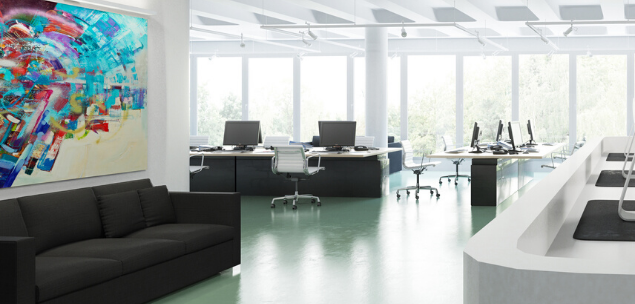Efficient work environments are a trending conversation amongst corporate leaders and business owners. Yet the practical solution to their queries is in the implementation of artwork in the office. With countless ways to promote satisfaction amongst employees, there is no excuse to miss out on the opportunities to boost production and engagement, which are paramount to the success of any organisation.
One business paving the way in this field is ColourSpace, an arts social enterprise that helps organisations improve productivity within the workspace through artwork. Essentially, ColourSpace works to convert dated offices lacking efficient design into dynamic work environments that look and feel refreshed.
Research from the Business Committee for the Arts, Inc, in collaboration with the International Association for Professional Art Advisors, found that the inclusion of art in the workspace has an overall positive impact. 94% of the 800 employees from 32 organisations surveyed agreed that art does enhance the work environment, with a further 64% believing that art can boost productivity and creativity.
Founder and CEO of ColourSpace, entrepreneur Scott Ko, launched the enterprise in 2016, with the aim to provide businesses and organisations with an economically viable solution to improve yield through art.
“I came up with the idea of ColourSpace while sitting in the office space at my previous job,” noted Mr Ko. “The office had someone come through regularly to change the fake flowers near reception, however, when I asked if it was possible to change the artwork that had been on the walls for almost a decade I was met with a chorus of, ‘too expensive, too hard, we don’t know how.’ So, I thought, what if I created a service that changed the art instead?”
Investing in the exponential growth of the local art industry is also part of ColourSpace’s agenda says Mr Ko, with the enterprise sourcing its art directly from emerging artists across Australia, who share in the revenue.
Since its foundation, ColourSpace has contributed approximately $45,000 in revenue to artists through royalties and sales. This is along with their decision to contribute 10% of their revenue towards art programs for disadvantaged regional communities, therefore speaking to the nature of efficient purpose-driven business.
“We transform staid environments into dynamic galleries by displaying and changing art on a regular basis. In doing so, we create social and economic opportunities for these local artists and meaningfully support Australia’s local art industry.”
The transformational role of art is increasingly growing in profile, becoming a successful business strategy that numerous workplaces are optimising the benefits.
“Regularly changing office art gives employees something new and inspiring to engage with. It can spark discussions, inspire and foster creativity and has been proven to positively impact mental health,” said Mr Ko.
Flexible workspaces in demand
Data from a recent Colliers International report (The Flexible Workspace Outlook Report 2019) suggests that flexible workspaces will be on the rise in 2020, with a focus on productivity, flexibility and collaboration. A focus on collaborative communication has seen significant success, especially in the form of CreativeCubes.Co, one of the key players within the coworking sphere.
“We will see the flexible workspace sector evolve with new iterations that will continue to disrupt traditional views of what the sector is and continue to pioneer new products to benefit occupiers and critically, their workforces,” explained Head of Flexible Workspace Services, Jonathan Wright.
Efficiently designed spaces could satisfy this concern of practicality, reveals the findings from the Colliers International report. This in turn will encourage employees, as it provides them with an ideal work environment for engaged production.
“Cramming an end user into a small glass box with cheap furniture is no one’s idea of an inspiring workspace and in no way is this conducive to productivity or wellness. Occupiers will begin to look at less-tangible metrics such as wellness, staff retention and productivity, rather than the obvious financial benefits of squeezing space densities,” concluded Mr Wright.
This focus on wellness and happiness in the office is key, as a satisfied workforce will lead to your business flourishing. The tradition of working 9-5 has become a dissatisfaction amongst employees, leaving organisations to reflect on their capacity to meet the structural changes now expected by their workers. With discussion still circulating around the practicality of a four-day working week, it is evident that maintaining an efficient and motivated workforce is essential for any business.
Initiatives like ColourSpace could therefore be an efficient solution in the quest for sustained motivation in the office.
Keep up to date with our stories LinkedIn, Twitter, Facebook and Instagram.

